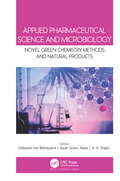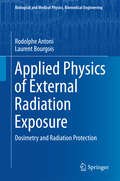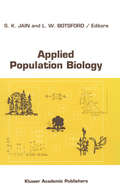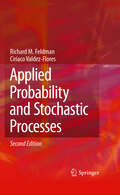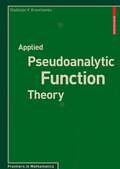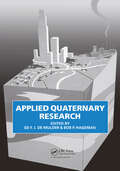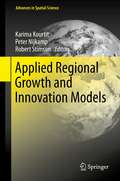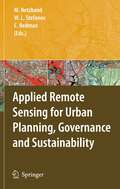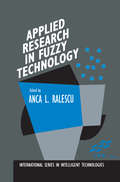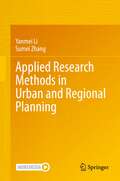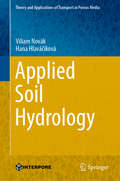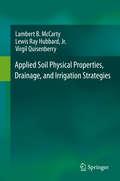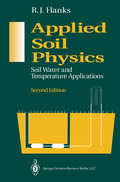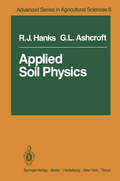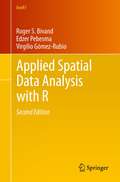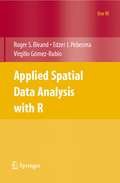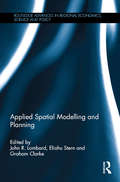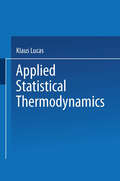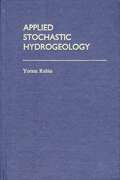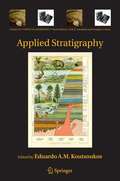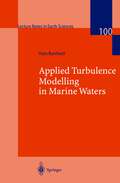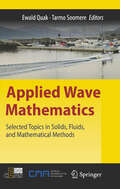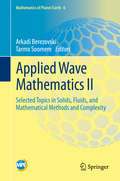- Table View
- List View
Applied Pharmaceutical Science and Microbiology: Novel Green Chemistry Methods and Natural Products
by Debarshi Kar Mahapatra Swati Gokul Talele A. K. HaghiThis volume on applied pharmaceutical science and microbiology looks at the latest research on the applications of natural products for drug uses. It focuses on understanding how to apply the principles of novel green chemistry methods in the vital area of pharmaceuticals and covers the important aspects of green microbial technology in the pharmaceutical industry. Chapters include studies on the applications of natural products used in folk and regional medicines, such as for digestive problems, dermatological infections, respiratory diseases, vessel diseases, diarrhea and dysentery, ringworms, boils, fevers (antipyretic), skin and blood diseases, mouth sores, channel discharges, and even cancer. The volume also looks at medical benefit of microbial fermentation for the conservation of nutrients.
Applied Physics of External Radiation Exposure: Dosimetry and Radiation Protection (Biological and Medical Physics, Biomedical Engineering)
by Rodolphe Antoni Laurent BourgoisThis book describes the interaction of living matter with photons, neutrons, charged particles, electrons and ions. The authors are specialists in the field of radiation protection. The book synthesizes many years of experiments with external radiation exposure in the fields of dosimetry and radiation shielding in medical, industrial and research fields. It presents the basic physical concepts including dosimetry and offers a number of tools to be used by students, engineers and technicians to assess the radiological risk and the means to avoid them by calculating the appropriate shields. The theory of radiation interaction in matter is presented together with empirical formulas and abacus. Numerous numerical applications are treated to illustrate the different topics. The state of the art in radiation protection and dosimetry is presented in detail, especially in the field of simulation codes for external exposure to radiation, medical projects and advanced research. Moreover, important data spread in different up to date references are presented in this book. The book deals also with accelerators, X-rays facilities, sealed sources, dosimetry, Monte Carlo simulation and radiation regulation. Each chapter is split in two parts depending on the level of details the readers want to focus on. The first part, accessible to a large public, provides a lot of simple examples to help understanding the physics concepts under radiation external exposure. The second part, called “Additional Information” is not mandatory; it aims on explaining topics more deeply, often using mathematical formulations. The book treats fundamental radiometric and dosimetric quantities to describe the interaction in materials under the aspects of absorbed dose processes in tissues. Definitions and applications on limited and operational radiation protection quantities are given. An important aspect are practical engineering tools in industrial, medical and research domains. Source characterization and shielding design are addressed. Also more ”exotic” topics, such as ultra intense laser and new generation accelerators, are treated. The state of the art is presented to help the reader to work with the book in a self-consistent way. The basic knowledge necessary to apply Monte Carlo methods in the field of radiation protection and dosimetry for external radiation exposure is provided. Coverage of topics such as variance reduction, pseudo-random number generation and statistic estimators make the book useful even to experienced Monte Carlo practitioners. Solved problems help the reader to understand the Monte Carlo process. The book is meant to be used by researchers, engineers and medical physicist. It is also valuable to technicians and students.
Applied Population Biology (Monographiae Biologicae #67)
by S. K. Jain L. W. BotsfordAn increasing variety of biological problems involving resource management, conservation and environmental quality have been dealt with using the principles of population biology (defined to include population dynamics, genetics and certain aspects of community ecology). There appears to be a mixed record of successes and failures and almost no critical synthesis or reviews that have attempted to discuss the reasons and ways in which population biology, with its remarkable theoretical as well as experimental advances, could find more useful application in agriculture, forestry, fishery, medicine and resource and environmental management. This book provides examples of state-of-the-art applications by a distinguished group of researchers in several fields. The diversity of topics richly illustrates the scientific and economic breadth of their discussions as well as epistemological and comparative analyses by the authors and editors. Several principles and common themes are emphasized and both strengths and potential sources of uncertainty in applications are discussed. This volume will hopefully stimulate new interdisciplinary avenues of problem-solving research.
Applied Probability and Stochastic Processes
by Richard M. Feldman Ciriaco Valdez-FloresThis book is a result of teaching stochastic processes to junior and senior undergr- uates and beginning graduate students over many years. In teaching such a course, we have realized a need to furnish students with material that gives a mathematical presentation while at the same time providing proper foundations to allow students to build an intuitive feel for probabilistic reasoning. We have tried to maintain a b- ance in presenting advanced but understandable material that sparks an interest and challenges students, without the discouragement that often comes as a consequence of not understanding the material. Our intent in this text is to develop stochastic p- cesses in an elementary but mathematically precise style and to provide suf?cient examples and homework exercises that will permit students to understand the range of application areas for stochastic processes. We also practice active learning in the classroom. In other words, we believe that the traditional practice of lecturing continuously for 50 to 75 minutes is not a very effective method for teaching. Students should somehow engage in the subject m- ter during the teaching session. One effective method for active learning is, after at most 20 minutes of lecture, to assign a small example problem for the students to work and one important tool that the instructor can utilize is the computer. So- times we are fortunate to lecture students in a classroom containing computers with a spreadsheet program, usually Microsoft’s Excel.
Applied Pseudoanalytic Function Theory (Frontiers in Mathematics)
by Vladislav V. KravchenkoPseudoanalytic function theory generalizes and preserves many crucial features of complex analytic function theory. The Cauchy-Riemann system is replaced by a much more general first-order system with variable coefficients which turns out to be closely related to important equations of mathematical physics. This relation supplies powerful tools for studying and solving Schrödinger, Dirac, Maxwell, Klein-Gordon and other equations with the aid of complex-analytic methods. The book is dedicated to these recent developments in pseudoanalytic function theory and their applications as well as to multidimensional generalizations. It is directed to undergraduates, graduate students and researchers interested in complex-analytic methods, solution techniques for equations of mathematical physics, partial and ordinary differential equations.
Applied Quaternary Research
by ED F.J.DE MULDER Bob P. HagemanProceedings of a symposium at the 1987 INQUA Congress, Ottawa, Aug. 1987. Contributions present the application of quaternary studies to land use planning and development. No index. Annotation copyright Book News, Inc. Portland, Or.
Applied Quaternary Research
by B. P. Hageman E. F. J. De MulderProceedings of a symposium at the 1987 INQUA Congress, Ottawa, Aug. 1987. Contributions present the application of quaternary studies to land use planning and development. No index. Annotation copyright Book News, Inc. Portland, Or.
Applied Regional Growth and Innovation Models (Advances in Spatial Science)
by Karima Kourtit Peter Nijkamp Robert StimsonModern spatial-economic systems exhibit a high degree of dynamics as a result of technological progress, demographic evolution or global change. In the past decade, an avalanche of new regional economic growth and innovation models has been put forward. This volume contains a unique collection of operational models of a strong applied nature that may be seen as original landmarks in the rich tradition of spatial-economic growth modelling. The contributors are recognized experts from different parts of the world.
Applied Remote Sensing for Urban Planning, Governance and Sustainability
by Maik Netzband William L. Stefanov Charles RedmanThis evaluation of the potential of remote sensing of urban areas helps to close a gap between the research-focused results offered by the "urban remote sensing" community, and the application of these data and products by the governing bodies of cities and urban regions. The authors present data from six urban regions worldwide. They explain what the important questions are, and how data and scientific skills can help answer them.
Applied Research in Fuzzy Technology: Three years of research at the Laboratory for International Fuzzy Engineering (LIFE), Yokohama, Japan (International Series in Intelligent Technologies #1)
by A. L. RalescuFuzzy logic is `a recent revolutionary technology' which has brought together researchers from mathematics, engineering, computer science, cognitive and behavioral sciences, etc. The work in fuzzy technology at the Laboratory for International Fuzzy Engineering (LIFE) has been specifically applied to engineering problems. This book reflects the results of the work that has been undertaken at LIFE with chapters treating the following topical areas: Decision Support Systems, Intelligent Plant Operations Support, Fuzzy Modeling and Process Control, System Design, Image Understanding, Behavior Decisions for Mobile Robots, the Fuzzy Computer, and Fuzzy Neuro Systems. The book is a thorough analysis of research which has been implemented in the areas of fuzzy engineering technology. The analysis can be used to improve these specific applications or, perhaps more importantly, to investigate more sophisticated fuzzy control applications.
Applied Research Methods in Urban and Regional Planning
by Yanmei Li Sumei ZhangThis book introduces the fundamentals of research methods and how they apply to the discipline of urban and regional planning. Written at a level appropriate for upper-level undergraduate and beginning master’s level students, the text fills a gap in the literature for textbooks on urban planning. Additionally, the book can be used as a reference for planning practitioners and researchers when analyzing quantitative and qualitative data in urban and regional planning and related fields.The volume does not assume advanced knowledge of mathematical formulas. Rather, it begins with the essentials of research methods, such as the identification of the research problems in planning, the literature review, data collection and presentation, descriptive data analysis, and report of findings. Its discipline-specific topics include field research methods, qualitative data analysis, economic and demographic analysis, evaluation research, and methods in sub-disciplines such as land use planning, transportation planning, environmental planning, and housing analysis. Designed with instruction in mind, this book features downloadable materials, including learning outcomes, chapter highlights, chapter review questions, datasets, and certain Excel models. Students will be able to download review questions to enhance the learning process and datasets to practice methods.
Applied Soil Hydrology (Theory and Applications of Transport in Porous Media #32)
by Viliam Novák Hana HlaváčikováThis state-of-the-art book clearly explains the basic principles of soil hydrology and the current knowledge in this field. It particularly highlights the estimation and application of measurements and evaluation of soil-hydrophysical characteristics using simulation models, with a focus on elucidating the basic hydrophysical characteristics of soil, such as soil water potential and hydraulic conductivity, as well as the methods of measurement. It also addresses topics such as stony soil, water repellent soils, and water movement modeling in those media. The book presents soil hydrology in a simple way, while quantitatively expressing the soil water state and movement. It clearly and precisely describes basic terms of soil hydrology with a minimum of mathematics. It also includes the latest research findings in the field as well as the basics of the mathematical modeling of water movement in the soil-plant-atmosphere system (SPAS), using original research results to illustrate these issues.This book is of interest to all scientists and professionals in soil hydrology, including beginners, as well as those interested and working in hydrology in general and soil hydrology in particular. In addition, it can also be used by specialists and students in related fields like agronomy, forestry, meteorology, hydrology, environmental engineering, environmental protection, and geography.
Applied Soil Physical Properties, Drainage, and Irrigation Strategies.
by Lambert B. McCarty Lewis Ray Hubbard, Jr. Virgil QuisenberryThe book is a realistic blend of basic knowledge and understanding in soil physical properties. It will enable the reader to scientifically analyze soils to develop practical and successful means of providing sufficient drainage and to develop science-based irrigation strategies. Only basic mathematical knowledge is necessary to understand and apply the proven principles covered. With limited resources that are increasing significantly in costs, the book blends the ideal concept of providing sufficient drainage and irrigation based on using soil physical properties but with financial limitations in mind. One traditional problem with many Soil Physics, Drainage, and Irrigations-based texts is the prerequisite of understanding complicated calculus-based mathematics. Although necessary for a theory-based text, our text was developed with practitioners in mind where such complicated mathematics was avoided but referenced if the reader wishes to further explore the specific topic. Another problem with many traditional texts is the lack of practical examples or case-studies allowing readers to relate their specific scenarios to similar types of situations. We have purposely included numerous examples and practical field experiences. This is especially true when many of the theoretical ideals are covered, followed by explanations of how such ideals can be applied in the laboratory and field.
Applied Soil Physics: Soil Water and Temperature Applications (Advanced Series in Agricultural Sciences #8)
by R.J. HanksThis second edition was undertaken to update information which has become available since the first edition and to convert completely to the SI system. The main objective of this book is to stress application of soil physics principles to real problems. The problems are heavily oriented toward the soil water-plant-atmosphere continuum. This book grew out of a course taught to upper level undergraduate and graduate students from many different disciplines and backgrounds. I have found that problems are a very good teaching tool because students need to solve them on their own and adapt them to their own understanding. I have found this problem-solving experience to be greatly enhanced if examples are available. Thus, this book is heavily laden with examples. This edition includes reference to many models, involving basic concepts discussed herein, by which it is possible to solve many more realistic--and more complex--problems such as drainage below the root zone (and associated pollution), plant growth as related to climate, soil properties, management, etc. The intent is to encourage students to advance to the next level. The book is not intended to be a complete introduction to applied soil physics, but rather to emphasize problem-solving and the important aspects of soil water and temperature.
Applied Soil Physics: Soil Water and Temperature Applications (Advanced Series in Agricultural Sciences #8)
by R. J. Hanks G. L. AshcroftApplied Spatial Data Analysis with R (Use R! #10)
by Roger S. Bivand Edzer Pebesma Virgilio Gómez-RubioApplied Spatial Data Analysis with R, second edition, is divided into two basic parts, the first presenting R packages, functions, classes and methods for handling spatial data. This part is of interest to users who need to access and visualise spatial data. Data import and export for many file formats for spatial data are covered in detail, as is the interface between R and the open source GRASS GIS and the handling of spatio-temporal data. The second part showcases more specialised kinds of spatial data analysis, including spatial point pattern analysis, interpolation and geostatistics, areal data analysis and disease mapping. The coverage of methods of spatial data analysis ranges from standard techniques to new developments, and the examples used are largely taken from the spatial statistics literature. All the examples can be run using R contributed packages available from the CRAN website, with code and additional data sets from the book's own website. Compared to the first edition, the second edition covers the more systematic approach towards handling spatial data in R, as well as a number of important and widely used CRAN packages that have appeared since the first edition. This book will be of interest to researchers who intend to use R to handle, visualise, and analyse spatial data. It will also be of interest to spatial data analysts who do not use R, but who are interested in practical aspects of implementing software for spatial data analysis. It is a suitable companion book for introductory spatial statistics courses and for applied methods courses in a wide range of subjects using spatial data, including human and physical geography, geographical information science and geoinformatics, the environmental sciences, ecology, public health and disease control, economics, public administration and political science. The book has a website where complete code examples, data sets, and other support material may be found: http://www.asdar-book.org. The authors have taken part in writing and maintaining software for spatial data handling and analysis with R in concert since 2003.
Applied Spatial Data Analysis with R (Use R!)
by Roger S. Bivand Edzer J. Pebesma Virgilio Gómez-RubioWe began writing this book in parallel with developing software for handling and analysing spatial data withR (R Development Core Team, 2008). - though the book is now complete, software development will continue, in the R community fashion, of rich and satisfying interaction with users around the world, of rapid releases to resolve problems, and of the usual joys and frust- tions of getting things done. There is little doubt that without pressure from users, the development ofR would not have reached its present scale, and the same applies to analysing spatial data analysis withR. It would, however, not be su?cient to describe the development of the R project mainly in terms of narrowly de?ned utility. In addition to being a communityprojectconcernedwiththedevelopmentofworld-classdataana- sis software implementations, it promotes speci?c choices with regard to how data analysis is carried out.R is open source not only because open source software development, including the dynamics of broad and inclusive user and developer communities, is arguably an attractive and successful development model.
Applied Spatial Modelling and Planning (Routledge Advances in Regional Economics, Science and Policy)
by John R. Lombard, Eliahu Stern and Graham ClarkeThis book highlights the extraordinary range of areas to which geographical analysis and spatial modelling can bring lessons and insights. It shows how these techniques have been used to address ‘real world’ issues that are of concern to international organisations, public agencies and businesses, as illustrated by actual funded projects that geographers have developed collaboratively with end-users. Applied Spatial Modelling and Planning shows how much geographical research is policy relevant to a wide variety of agencies through the use of GIS and spatial modelling in applied geography. The book’s chapters contain a cross-section of innovative applications and approaches to problem solving within five major domains of the dynamics of economic space, housing and settlements, population movements and population ageing, health care, and the environment. Using a number of case studies on the use of GIS and spatial modelling, this book demonstrates the fact that much of what is done by quantitative geographers is not only relevant within academia, but also has use in policy work. This book will appeal to an international audience interested in cutting-edge spatial modelling to better understand the processes involved in solving real problems.
Applied Spatial Modelling and Planning (Routledge Advances in Regional Economics, Science and Policy)
by John R. Lombard Eliahu Stern Graham ClarkeThis book highlights the extraordinary range of areas to which geographical analysis and spatial modelling can bring lessons and insights. It shows how these techniques have been used to address ‘real world’ issues that are of concern to international organisations, public agencies and businesses, as illustrated by actual funded projects that geographers have developed collaboratively with end-users. Applied Spatial Modelling and Planning shows how much geographical research is policy relevant to a wide variety of agencies through the use of GIS and spatial modelling in applied geography. The book’s chapters contain a cross-section of innovative applications and approaches to problem solving within five major domains of the dynamics of economic space, housing and settlements, population movements and population ageing, health care, and the environment. Using a number of case studies on the use of GIS and spatial modelling, this book demonstrates the fact that much of what is done by quantitative geographers is not only relevant within academia, but also has use in policy work. This book will appeal to an international audience interested in cutting-edge spatial modelling to better understand the processes involved in solving real problems.
Applied Statistical Thermodynamics
by Klaus LucasThe book guides the reader from the foundations of statisti- cal thermodynamics including the theory of intermolecular forces to modern computer-aided applications in chemical en- gineering and physical chemistry. The approach is new. The foundations of quantum and statistical mechanics are presen- ted in a simple way and their applications to the prediction of fluid phase behavior of real systems are demonstrated. A particular effort is made to introduce the reader to expli- cit formulations of intermolecular interaction models and to show how these models influence the properties of fluid sy- stems. The established methods of statistical mechanics - computer simulation, perturbation theory, and numerical in- tegration - are discussed in a style appropriate for newcom- ers and are extensively applied. Numerous worked examples illustrate how practical calculations should be carried out.
Applied Stochastic Hydrogeology
by Yoram RubinStochastic Subsurface Hydrogeology is the study of subsurface, geological heterogeneity, and its effects on flow and transport process, using probabilistic and geostatistical concepts. This book presents a rational, systematic approach for analyzing and modeling subsurface heterogeneity, and for modeling flow and transport in the subsurface, and for prediction and decision-making under uncertainty. The book covers the fundamentals and practical aspects of geostatistics and stochastic hydrogeology, coupling theoretical and practical aspects, with examples, case studies and guidelines for applications, and provides a summary and review of the major developments in these areas.
Applied Stratigraphy (Topics in Geobiology #23)
by Eduardo A. M. KoutsoukosStratigraphy has come to be indispensable to nearly all branches of the earth sciences, assisting such endeavors as charting the course of evolution, understanding ancient ecosystems, and furnishing data pivotal to finding strategic mineral resources. This book focuses on traditional and innovative stratigraphy techniques and how these can be used to reconstruct the geological history of sedimentary basins and in solving manifold geological problems and phenomena.
Applied Turbulence Modelling in Marine Waters (Lecture Notes in Earth Sciences #100)
by Hans BurchardThe simulation of turbulent mixing processes in marine waters is one of the most pressing tasks in oceanography. It is rendered difficult by the various complex phenomena occurring in these waters like strong stratification, ex ternal and internal waves, wind generated turbulence, Langmuir circulation etc. The need for simulation methods is especially great in this area because the physical processes cannot be investigated in the laboratory. Tradition ally, empirical bulk type models were used in oceanography, which, however, cannot account for many of the complex physical phenomena occurring. In engineering, statistical turbulence models describing locally the turbulence mixing processes were introduced in the early seventies, such as the k E model which is still one of the most widely used models in Computational Fluid Dy namics. Soon after, turbulence models were applied more and more also in the atmospheric sciences, and here the k kL model of Mellor and Yamada became particularly popular. In oceanography, statistical turbulence mod els were introduced rather late, i. e. in the eighties, and mainly models were taken over from the fields mentioned above, with some adjustments to the problems occurring in marine waters. In the literature on turbulence model applications to oceanography problems controversial findings and claims are reported about the various models, creating also an uncertainty on how well the models work in marine water problems.
Applied Wave Mathematics: Selected Topics in Solids, Fluids, and Mathematical Methods
by Ewald Quak Tarmo SoomereThis edited volume consists of twelve contributions related to the EU Marie Curie Transfer of Knowledge Project Cooperation of Estonian and Norwegian Scienti c Centres within Mathematics and its Applications, CENS-CMA (2005-2009), - der contract MTKD-CT-2004-013909, which ?nanced exchange visits to and from CENS, the Centre for Nonlinear Studies at the Institute of Cybernetics of Tallinn University of Technology in Estonia. Seven contributions describe research highlights of CENS members, two the work of members of CMA, the Centre of Mathematics for Applications,Univ- sity of Oslo, Norway, as the partner institution of CENS in the Marie Curie project, and three the ?eld of work of foreign research fellows, who visited CENS as part of theproject. Thestructureofthebookre?ectsthedistributionofthetopicsaddressed: Part I Waves in Solids Part II Mesoscopic Theory Part III Exploiting the Dissipation Inequality Part IV Waves in Fluids Part V Mathematical Methods The papers are written in a tutorial style, intended for non-specialist researchers and students, where the authors communicate their own experiences in tackling a problem that is currently of interest in the scienti?c community. The goal was to produce a book, which highlights the importance of applied mathematics and which can be used for educational purposes, such as material for a course or a seminar. To ensure the scienti?c quality of the contributions, each paper was carefully - viewed by two international experts. Special thanks go to all authors and referees, without whom making this book would not have been possible.
Applied Wave Mathematics II: Selected Topics in Solids, Fluids, and Mathematical Methods and Complexity (Mathematics of Planet Earth #6)
This book gathers contributions on various aspects of the theory and applications of linear and nonlinear waves and associated phenomena, as well as approaches developed in a global partnership of researchers with the national Centre of Excellence in Nonlinear Studies (CENS) at the Department of Cybernetics of Tallinn University of Technology in Estonia.The papers chiefly focus on the role of mathematics in the analysis of wave phenomena. They highlight the complexity of related topics concerning wave generation, propagation, transformation and impact in solids, gases, fluids and human tissues, while also sharing insights into selected mathematical methods for the analytical and numerical treatment of complex phenomena. In addition, the contributions derive advanced mathematical models, share innovative ideas on computing, and present novel applications for a number of research fields where both linear and nonlinear wave problems play an important role.The papers are written in a tutorial style, intended for non-specialist researchers and students. The authors first describe the basics of a problem that is currently of interest in the scientific community, discuss the state of the art in related research, and then share their own experiences in tackling the problem.Each chapter highlights the importance of applied mathematics for central issues in the study of waves and associated complex phenomena in different media. The topics range from basic principles of wave mechanics up to the mathematics of Planet Earth in the broadest sense, including contemporary challenges in the mathematics of society. In turn, the areas of application range from classic ocean wave mathematics to material science, and to human nerves and tissues. All contributions describe the approaches in a straightforward manner, making them ideal material for educational purposes, e.g. for courses, master class lectures, or seminar presentations.
